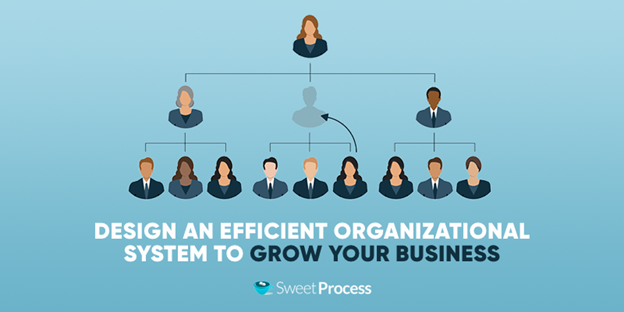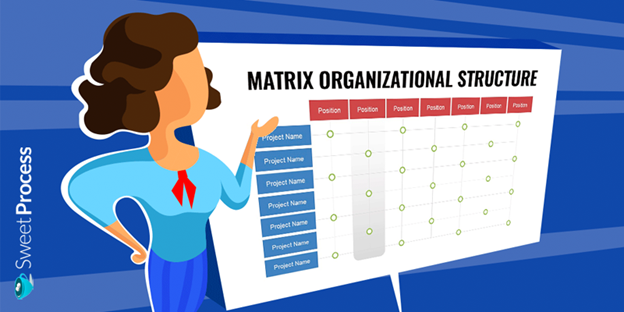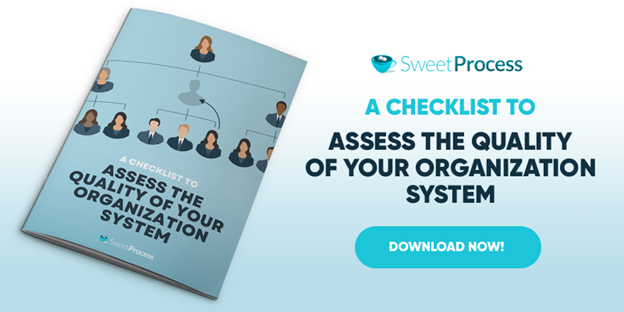Design an Efficient Organizational System to Grow Your Business
Last Updated on March 1, 2024 by Owen McGab Enaohwo

If you’ve just started a business, you’re probably involved in all the core departments: accounting, R&D, marketing, sales, and customer care. Aside from the mental and physical strain, you feel everything is going well. You may not see any need to put a system in place because you think you can handle challenges and issues as they come.
However, as the company grows and you start to delegate some of the roles, you start to notice constant miscommunication between the departments. Why is the R&D division single-handedly commissioning expensive projects that the company can’t finance? And why did IT sign contracts for maintenance that the legal department didn’t review? The sales manager dismissed an employee without notice, and she is now suing the company.
What went wrong and how can you fix it?
What you have is a group of disjointed departments claiming to be part of one company. What you need is a system to create a team out of the current mess. A good system will allow you to harness and combine the effort from the employees, management, and other stakeholders and take the company to greater success.
But how do you design such a system?
In this article, we will cover what you should know about organizational systems, their importance, the different types, and how to design one.
Chapter 1: What are Organizational Systems?
Chapter 2: Types of Organizational Systems
Chapter 3: Importance of Organizational Systems in Business
Chapter 4: How to Design and Create Organizational Systems
Chapter 5: Types of Software That Assist Organizational Systems
Chapter 6: Leadership and Organizational Systems
Chapter 7: Using SweetProcess to Build Effective Organizational Systems
Chapter 1: What are Organizational Systems?

Organizational systems refer to the structure of a company. This includes the definition of all business divisions and sectors, the communication flow, and reporting hierarchy.
In addition, this system is put in place to define how each role in the business functions. Employees also get a clear guideline of who they should report to and what are their specific roles.
The organizational system determines how information flows between departments to help the company remain efficient. A successful and well-defined system defines each employee’s role in the company and how it aligns with the company goals. It also provides a visual representation of how the company is structured.
Beyond maintaining internal order, having a well-defined organizational system also defines interactions with external stakeholders. It also defines who is authorized to interact with customers, competitors, shareholders, and government agencies, and how they should do it. Such a system ensures that the organization acts as one unit and not disorganized parts. It also makes it easier to pinpoint the source of an error incident and administer corrective measures.
A functional system will, therefore, result in order within departments, between departments, and with the organization’s external environment.
It is, however, important to note that an organizational system that works for one company might not be a good fit for your company. Therefore, take your time when choosing one, depending on the industry, business goals, and company culture.
The type of organizational system you select is just as important as the products you are selling, the long-term strategy, and the marketing plan. On the other hand, if you don’t design an organizational system for your company, you might have a problem with reporting and role allocation.
It’s vital for every business to have an organizational system in place, whether small or large. These systems come with many benefits from improved productivity, efficiency, and better decision-making.
An example of a basic organizational system involves a sales team that reports to a sales manager, who then reports to the company’s managing director, who is the final decision-maker.
Chapter 2: Types of Organizational Systems

Every company has a different type of organizational system. These structures are developed depending on work processes, departments and role division. The size of the company and leadership style may also affect the type of system that is adopted by a company.
Here are the common types of organizational systems.
Distinction Between Open-Ended and Close-Ended Systems
An organizational system can either be open-ended or close-ended. But what’s the difference between the two?
Open-ended systems interact with other systems or environments; therefore, they are more flexible than closed systems which are rigid. It views an organization as an entity that takes inputs from the external environment, such as shareholders and the market, through the free passing of information.
Since it’s not rigid, an organization with an open-ended system has the capacity to change and adapt to the needs of the company.
On the other hand, close-ended systems operate with little or no influence from the environment. Employees who work in such a system don’t communicate with other departments about their projects and don’t receive any input from outside.
Closed-ended systems can easily cause the organization and employees to stagnate because they do not observe and adopt what is happening beyond their design. This can cause the organization to miss out on disruptive technologies, talents, and ideas that could help grow the business.
However, close-ended systems are more efficient because they have clear procedures that are not affected by outside influences. This can be a saving where other organizations adopt popular ideas that eventually prove to be terrible mistakes.
Functional
A functional organizational system is the most common and traditional form of structure. Also known as the bureaucratic organizational structure, it’s adopted mainly by larger corporations.
In this system, all the employees who work on specific functions are put together to form a department. These specialized divisions include sales, marketing, finance, and human resources and operations.
A functional structure comes with a firm hierarchy. Every department has a senior manager who oversees the operations, and the reporting flow is clear.
Every employee reports directly to their division head, who then reports to senior management. The senior managers might be in charge of more than one department.
There are many advantages to this structure:
- Employees become specialized.
- There’s a clear path for promotion and growth.
- The chain of command is clear, and everyone knows their role.
- Personnel can share ideas and become more efficient.
However, the system also has its own downsides:
- Communication limitation between different departments.
- Employees are more isolated within their departments due to little horizontal communication.
- Employees could develop tunnel vision due to focusing on one department.
- Except for the top management, there’s little space for the whole company to interact.
- The functional organizational system is slow to adapt to change.
Divisional
The divisional organizational system divides the business into teams based on the staff’s projects. This can be public relations, legal, research, or business development.
Every project team has a leader or manager to whom they report to. For instance, a fast moving consumer goods (FMCG) company might have different departments for each product they deal in.
With this structure, a business can also opt to organize the company’s activities according to the market or geographical groups. If the company has operations in the European and American markets, a division can be designated to operate in each market.
In this case, every division has its own set of functional departments, from sales, accounting to marketing. This system is popular among companies that operate in different markets or have numerous products.
What are some of the advantages of this organizational system?
- The employees become intensively familiar with their team’s work.
- Employees can be accountable because results are easily identifiable.
- In divisions, the staff can develop their unique culture and tailor it to the customers.
- The structure reduces the bureaucracy and hierarchy problems to allow quick decision-making.
Here are the disadvantages:
- Each division is unaware of what the other is doing.
- Little to no communication between divisions, which can affect business efficiency.
- The divisions are costly to set up.
- The business will need more employees to work on the functional departments.
- Inter-divisional conflicts and rivalries might arise between division managers.
Matrix
The matrix organizational system is a combination of functional and divisional structures.
This system is commonly adopted by companies that are starting a new marketing campaign or creating and launching new products.
Unlike the other two, which are pretty direct, the matrix system is quite complex. It’s set up with a functional structure that comes with a traditional hierarchy and specialized divisions. However, the divisions are set up in a divisional system.Therefore, the employees are split according to their projects and into smaller teams.
A matrix organization gains benefits from both structures by fostering cooperation between all the company departments so that every business goal can be managed efficiently.
Because of the structure, the matrix system has two chains of command: one for the functional teams and one for the project. Project managers have authority across the departments.
A matrix system comes with the following benefits:
- There’s a clear objective such as launching a new product or service.
- A matrix system brings together employees from different departments to exchange ideas and encourage cross-collaboration.
- Communication in the organization is more integrated than in other systems.
- The system eliminates most miscommunication issues from the functional and divisional structures.
Here are some of the downsides of this system:
- Setting up and executing the matrix structure is too complex.
- Employees report to two bosses because hierarchy runs horizontally and vertically.
- Conflicting directives from the functional managers and project managers can cause confusion among staff.
- The rate of conflicts increases due to many employees.
- This structure requires a lot of planning and strong systems of communication.
Flat
Just like its name, flat organization systems flatten most of the hierarchy, giving employees more autonomy.
Commonly used by startups and tech companies, this system gets rid of decentralized management and middle-level managers. Therefore, employees work as their own bosses and can communicate directly with their colleagues and boss about the projects and new ideas. While the employees might be split into temporary teams during some projects, there’s no formal structure.
The company is led by the founder or a senior manager, and the rest of the employees can generate fresh and profitable ideas that can be implemented by the entire company. If an employee has a project idea in mind, they don’t have to navigate through all levels of management to get the idea approved. Instead, they can share with their peers directly.
There are many advantages to this system:
- It’s a perfect system for self-starters because employees have more freedom.
- The company doesn’t need to spend more money hiring managers.
- Better communication across the teams compared to a top-down structure.
- The system encourages employee input and innovation.
However, the flat system also has some disadvantages. Here are some of them:
- This system is difficult to maintain. As the company grows, it requires a solid form of structured communication.
- Employees can get overwhelmed by too many tasks.
- There’s little room for growth and promotion.
Chapter 3: Importance of Organizational Systems in Business

Whether your business is a startup or you have been in existence for years, you need an organizational system to function.
The structure benefits both the business and the employees. If your company has proper organizational systems, here are the benefits you will reap.
They Streamline Company Hierarchy
Effective communication in the workplace is an essential part of business growth. When all roles are communicated clearly, there’s less confusion and a positive company culture.
However, according to statistics, 57 percent of employees report that their managers did not give them proper and direct instructions.
If a company has a well-functioning organizational system, there’s less confusion. Every staff member knows who they report to and what their roles are in the firm.
Additionally, managers can easily supervise staff in the lower management levels with clear reporting relationships. Employees also know who they need to talk to if they need help or want to address an issue within the company.
When there’s no structure, the company becomes chaotic because the staff doesn’t know who is responsible for what tasks.
If this continues, the employees will be less motivated to execute their jobs which affects the growth and profitability of the company in the long run.
They Allow Better Communication
According to a report, organizations with clear communication channels have a 20–25 percent productivity increase.
For every organizational system, you need to have effective communication between the managers and the employees.
While some of the systems only allow communication within the functional team or division, others, like the flat system, break down these barriers.
Therefore, when choosing a system for your business, it has to meet the company’s communication needs.
When employees exchange ideas on new products, services and projects, the company benefits more.
Furthermore, the staff in the lower management levels can use a direct line to their supervisor or manager to get opinions about the projects they are working on.
They Improve Overall Company Efficiency
With an organizational system in place, every employee knows their role and what they need to contribute to the team.
Because of this high level of clarity, every department functions without any hiccups because the goals are defined.
In addition, this structure allows the top management to make decisions because there’s a flow of information.
For each division or department, the upper-level managers can collect information from their teams and share it with the CEO or board of directors for implementation.
The system puts every piece in the right place and the business can function with little or no issues.
They Reduce Conflicts and Role Duplication
Work duplication is one of the top time wasters in an organization.
If the organizational system is not well defined, employees will overlap on projects and functions which can be demotivating and a loss to the company.
For instance, if the business is using the matrix system, there’s an increased risk of duplicating roles because employees need to report to their functional heads and project managers. In such a scenario, it’s advisable to be keener about who’s responsible for which projects to avoid further confusion. Furthermore, when employees are clear about what they need to do, they become more motivated to work together and collaborate across departments.
However, if there are lots of shifting goalposts and different directives from managers, this could lead to conflicts.
They Boost Efficient Task Completion
With a well-structured organizational system, your company can complete tasks and projects within the set timelines.
Project managers can plan effectively and assign their teams clear roles to ensure that all projects are executed properly.
Within a department, some employees are skilled differently. A project manager can assign roles according to individual strengths to boost faster task completion. On the other hand, if it’s a startup, the staff work together as peers, fostering collaboration and exchanging ideas. In this case, each employee can work on their particular area of expertise and deliver their part of the project in time. In addition, the staff can choose to work together to make it easier to complete the tasks.
They Facilitate Employee Promotions
Since the company has a working structure, employees can be easily promoted to senior roles.
However, this works better in systems such as the functional, divisional and matrix which have a top-down structure, making it easy to know who works on a particular role or project.
The project managers and functional heads can vouch for their team members, especially if they deliver on the specific jobs.
They Can Spark Business Growth and Expansion
The right organizational system could take your business to the next level.
If the company has the right team in the right places and a proper management system, there’s more room for expansion. A good system enables the managers to spot any deficiencies and weaknesses that need to be improved. This way, the company can focus on these spots and boost profitability.
However, to work for your company, you need to choose the right system. For instance, a flat system will be the most ideal if you are a startup or an incubator. On the other hand, if you have operations in different regions, you should use the divisional system. A proper structure is crucial for business growth.
Chapter 4: How to Design and Create Organizational Systems

For your business to be successful, you need to have a well-functioning organizational system.
While we have identified the different types of systems that you can choose, how can you design and create some for your business? If you already have one in place, how can you restructure it? Here’s how to get started.
How to Tell That Your Systems Need to be Redesigned or Restructured
Company reorganization and restructuring might sound scary but it’s a necessary step in business growth.
Your systems need to be redesigned when there are new changes and threats to the business both internal and external.
A restructuring involves changing internal processes, reorganizing teams, adopting new strategies, and market repositioning.
But how do you know when you need to redesign and restructure? Here are the signs:
- Your Competition Has Changed
In today’s business landscape, innovation and technologies are disrupting how businesses operate.
Every month, there are new players in the industry with better products and services. Therefore, to keep up with the competition, you also need to reexamine your organizational system and update your strategy.
- You Have Merged With Another Company
A new business needs a new organizational system to operate. Therefore, if you merge with another company, you have to change the structure.
The system you select should work for both players and fit within the business goals moving forward.
- Your Employee Skills Don’t Match
Employees are one of the most crucial parts of your business. Therefore, if they don’t match your business functions, it’s time to hire the right people.
You can also reorganize the current employees by combining teams and departments, hiring new people, laying off others, and investing in career training.
- You Have New Managers
Once a new CEO or managing director takes over a business, the first thing that most of them do is change the organizational system.
New leaders have to find ways to improve efficiency and turn things around if the company is making losses.
- Your Employee Turnover is High
According to the 2021 Bureau of Labor Statics report, the annual total turnover rate in 2020 was 57.3 percent. As a business owner, you need to monitor your turnover rate closely because this is a representation of your business.
Employees are valuable assets but if you keep losing your top staff, it’s time to reevaluate what the problem might be. In this case, you need to check and improve factors such as salaries, employee benefits, relationships with managers, and the hiring and onboarding process.
- Your Business Strategy Has Changed
If the business is planning to expand into different territories or introduce new products, you’ll need to change how you operate.
You can choose the ideal organizational system in accordance with your business goals.
- Your Company Performance is Dropping
Low business performance can result from poor employee engagement, poor management, lack of training and other factors. Once you notice that the performance metrics are lower than expected, it’s time for a company restructure.
For the new system to be effective, you’ll need to focus on all business areas.
- Your External Environment Has Changed
Apart from internal factors, your company’s performance is also heavily impacted by external elements.
For instance, customer preferences can change, or there are new government regulations. In this case, you’ll have to strategize and restructure your organizational system.
How to Design the Systems for New Businesses and Existing Businesses That Need Redesigning
If you just started a new business or have an existing one, here’s how you can design or redesign an organizational system.
Identify the main departments/sections of organization and how they connect
Before you start the process, you need to first identify the major departments in your company. For instance, if you have a mid-level company, you might have sales, marketing, finance, administration, human resource, business development and top management.
Once you have identified them you need to draw a plan about how each of them connects to each other to determine how much interaction the teams need to have.
For instance, teams in sales and marketing will have to work together most of the time. Therefore, you can adopt a divisional or matrix structure to cater to the projects.
When you have this in place, you can now develop a hierarchical structure for better efficiency. The following steps will help you determine the best system for your company and guide you through the implementation process.
Step 1: Identify One System
Once you have all the departments identified, it becomes easier to choose the type of system that will work for your organization.
Among the four types of systems, select one that aligns with the company goals.
For instance, if you are a tech startup, it’s highly likely that all the employees are skilled differently. Therefore, the flat system works best because everyone can work independently to meet the company goals.
Step 2: List the Pros and Cons
Every structure has its own advantages and disadvantages. Therefore, before settling on one, evaluate all the benefits and drawbacks.
This type of analysis enables you to see the best course of action that will suit your business.
After choosing the ideal system for your company, follow these steps for efficient implementation:
Develop Job Descriptions
Define what each employee does according to the skill set, what department or team they are in, and who they report to.
As a business owner, this will help you account for all the tasks and functions in the company as well as monitor management of staff.
Analyze Your Current Staff
Once you have come up with the job descriptions, you’ll need to analyze your current employees to determine whether they can grow with the company and take up senior roles in the future.
At this stage, you can develop career plans which include training.
In addition, after the analysis you can identify the gaps that need to be filled. Create job positions and descriptions for new hires and indicate the skills, experience, and education level that each of them needs to meet.
Design an Organizational Chart
The organizational chart should cover all the business hierarchies with clearly defined reporting relationships for each position.
With the chart, you can balance the employees and the management perfectly to ensure that every manager is supervising the right number of people.
Share the New System
Once you have the organizational system in place, present it to the employees and all the managers.
Doing this makes it easy for all the employees to adapt to the new changes and systems while undertaking their tasks.
Assessing the Organizational System
Once the organizational system is in place, you need to assess it constantly to identify areas that may need changes. Here are some tips on how to conduct the assessments:
- Review the organizational system annually
Every 12 months, evaluate your organizational system to determine whether it still aligns with your business goals.
Your organizational plan should have an evolutionary life; therefore, it should change if you have new company objectives, have hired new staff, or there is no growth.
- Consider alternative structures
If things have changed in the company, you should consider adopting a different organizational system. For instance, if the company has expanded into new regions or launched new products, you can change your system to a divisional structure.
- Implement corrective measures
If you are still keeping the current organizational system, implement corrective measures and changes gradually until you see improvements. An assessment should help you identify weak areas that need to be corrected.
Chapter 5: Types of Software That Assist Organizational Systems

For your organizational system to be effective, there are different types of software that you can use. Let’s take a closer look at some of them.
- Integrated Systems Software
This type of systems software is used to bring together different business processes. When you adopt this system in your organization, you can share information and data seamlessly within the organization.
Integrated systems software enhances productivity, reduces company expenses, optimizes data management and helps in faster decision-making.
Some of the integrated systems software companies use include Trello, Google Suite, One Drive, Hootsuite and Asana.
- Project Management Software
Project management software is useful in project planning, resource allocation, and project scheduling. This software enables project managers to communicate with the team members and is a useful tool for budgeting, quality management and documentation.
With tools such as Trello, Basecamp, Zoho Projects, Asana, or Microsoft Projects, an organization can use this to manage the project from start to finish.
- Customer Management Software
Most companies use customer relationship management (CRM) tools to administer interactions with their customers.
This software assists organizational systems to offer better customer service, identify and generate leads, and improve products and services.
Companies use different types of management software including Salesforce, HubSpot, Zoho, ActiveCampaign and Pipedrive.
- Organizational Process Software
This software is used to manage organizational processes and assets, which are the daily tasks and activities that take place in a company.
As you build your organizational system, these tools come in handy in ensuring that all the company procedures run as scheduled.
You can use organizational process software such as Google Suite, Dropbox, Zapier, Office 365, and Airtable.
Chapter 6: Leadership and Organizational Systems

For an organizational system to function properly, there requires a matching type of leadership structure to build and implement it. For instance, a system that involves liberal integration of ideas may not work in a military organization because such an organization is built on a hierarchical leadership structure where orders flow from top to bottom.
In turn, when choosing individuals to lead your organization, you need to take into account their character and whether it matches your organizational system. A person who finds it hard to receive criticism from his subordinates will not perform well as a leader in an organizational system that promotes feedback from employees.
Below is a review of the most common leadership styles and how they match with respective organizational systems:
- Democratic Leadership
Also known as participative leadership, it gives power to the employees. A leader implements decisions based on the input of all staff and managers.
Most employees prefer this type of leadership because they feel heard. It’s transparent, has a clear reporting structure and motivates employees.
However, it might become complicated for larger corporations. It’s mostly ideal for smaller companies and a flat organizational system where all staff are well skilled.
- Autocratic Leadership
Also referred to as authoritarian, this leadership style is where the boss has total power and control over all the decisions in the company. It mostly works in a functional or divisional organizational system where there’s a top-down structure.
While this leadership saves time during decision-making, it’s not very popular among employees because they are rarely involved in any of the decision-making processes.
This type of leadership could work in a high-stakes environment and emergencies but it wouldn’t be a good fit in a creative team with a flexible structure.
- Laissez-Faire Leadership
With this leadership style, the rules are totally relaxed. There’s no clear leader role and the management trusts the employees to make the best decisions and everyone is an equal decision-maker.
While this can motivate employees and make them feel valued, it could also lead to confusion and bottlenecks in the strategic business functions.
This leadership style is also ideal in companies where every employee is highly skilled in their area of expertise and they can take the lead in different situations. It works pretty well in a flat organizational system.
- Transformational Leadership
The transformational style of leadership is more common in growth-minded companies. The leader pushes the employees to achieve certain goals in a project and do more outside of their comfort zone.
The leader assigns different goals every week or month and sets deadlines for the team members. When you have this type of leader, the staff will be motivated to grow and take up more roles at work, especially when working on a project.
This style fits in a matrix, divisional and flat organizational system. The leader is well suited to inspire employees to work on their projects because they are not too rigid or flexible.
- Strategic Leadership
A strategic leader works on the company’s operations while pushing for growth opportunities. This type of leadership is desirable in all kinds of organizational systems because strategic thinking supports all employees and business functions.
However, as the business owner, you should assess the situation so that the leader is not managing too many people. Otherwise, they might become overwhelmed and affect the effectiveness of company processes.
Chapter 7: Using SweetProcess to Build Effective Organizational Systems

If you don’t know where to start to build an effective organizational system, SweetProcess has the right tools and software. The company offers a premium service that you can use to design your own organizational system and manage your employees and all business tasks from one place. If you are managing a team, it can help you assign and track tasks and collaborate in real-time.
With SweetProcess, you can set up teams and come up with processes and policies to be used in running the company. You can allow your team members to suggest improvements on different projects and give the managers the authority to approve them. You can also streamline all your processes and integrate apps for improved productivity and business growth.
Thomas Parker, the quality assurance and sensory coordinator at Stone & Wood, took up the task to resolve the absence of an effective organizational system in the company. The Microsoft Word documents and the binders that the team was working with were insufficient; therefore, he found a way to enhance the team members’ efficiency.
The company adopted the SweetProcess software for employee training and onboarding, and created a centralized base of knowledge, enabling them to meet regulatory standards. Having started with the production department, other departments in the company are now interested in adopting SweetProcess.
Jamie Ramsden, the business intelligence and Lean Six Sigma champion at Turkstra Lumber, identified the need to be more strategic and sophisticated in their operations. While the team was effective in performing their tasks without any documented processes, they weren’t coordinated, leading to too many inconsistencies. They tried using Excel Sheets to document their processes but the results were unsatisfactory; therefore, they decided to get something better.
Once the team discovered SweetProcess, they were able to streamline their operations and boost employee efficiency. With SweetProcess, the company now has effective documentation, a centralized knowledge base, improved employee efficiency, and team collaboration.
If you want to try out a software that can improve your organizational system, you should take advantage of the 14-day FREE trial and test how these processes work with your business. What’s better, you don’t need to share any credit card information until you are ready to sign up. Once you set up your information, you can start designing your organizational system and set up the processes to start growing your business. If the experience is not to your taste, you can always cancel your registration at your convenience.
If you are ready to get started, head over to SweetProcess and begin designing your organizational system today.
Conclusion
Organizational systems are a critical part of the company. You need to have a streamlined way of doing things, managing employees and handling all business tasks.
For your business to be successful, you need to choose the right organizational system. If you adopt the wrong one, there will be too much confusion due to poor structure.
The type of system you adopt should also align with your company goals, your company size, the number of employees and the type of products you deal in.
In addition, the organizational system you choose should match the leadership style of the company. Not every type of leadership will gel with your structure. Therefore, you need to analyze what your leadership style is before adopting a specific system.
If you already have an organizational system in place, it needs to be assessed annually to determine whether it still aligns with the company goals. If things have changed within your business or in the external environment, it’s never too late to adopt a new one to suit the current situation.
To help you get started on the process, we have put together a checklist to assess the quality of your organizational system. Download it below.
You can also sign up for the 14-day FREE trial of SweetProcess for seamless execution of your organizational system design strategy. No credit card required.










Leave a Reply